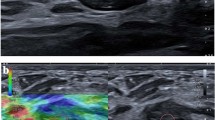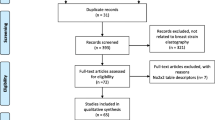Abstract
Objectives
The objectives of this study were to demonstrate the non-inferiority of assist strain ratio (ASR)—a newly developed application tool—to manual strain ratio (MSR)—a currently available standard diagnostic tool—and to calculate the sensitivity, specificity, positive predictive value (PPV), negative predictive value (NPV), and accuracy of MSR and ASR.
Methods
Ninety-eight mass lesions in the mammary gland (30 malignant and 68 benign) were included in the study. Skilled physicians performed the elastography scanning by applying minimal vibration. MSRs were obtained and compared with ASRs calculated from the same elastography image to test the correlation between the two groups of data.
Results
Diagnostic performance of MSR at a cut-off of 5.0 showed a sensitivity of 84.4 %, a specificity of 80.4 %, an accuracy of 81.6 %, a PPV of 65.5 %, and an NPV of 92.1 %. Diagnostic performance of ASR at a cut-off of 5.0 showed a sensitivity of 74.4 %, a specificity of 84.3 %, an accuracy of 81.3 %, a PPV of 67.7 %, and an NPV of 88.2 %. The areas under the curve (AUCs) for MSR and ASR were found to be 0.885 and 0.875, respectively.
Conclusion
ASR demonstrated excellent diagnostic potential and was highly correlated with MSR performed by skilled physicians (r = 0.69, p < 0.05).












Similar content being viewed by others
References
Ueno E, Tohno E, Soeda S, et al. Dynamic tests in real-time breast echography. Ultrasound Med Biol. 1988;14:53–7.
Krouskop TA, Wheeler TM, Kallel F, et al. Elastic moduli of breast and prostate tissue under compression. Ultrasonic Imag. 1998;20:260–74.
Umemoto T, Ueno E, Matsumura T, et al. Ex vivo and in vivo assessment of the non-linearity of elasticity properties of breast tissues for quantitative strain elastography. Ultrasound Med Biol. 2014;40:1755–68.
Ophir J, Céspedes I, Ponnekanti H, et al. Elastography : a quantitave method for imaging the elasticity of biological tissue. Ultrason Imag. 1991;13:111–35.
Shiina T, Doyley M, Bamber J, et al. Strain imaging using combined RF and envelope autocorrelation processing. proc. of 1996. IEEE Ultrasonics Symp. 1996;4:1331–6.
Murayama N, Waki K, Akamatsu I, et al. Development of real-time tissue elastography on EUB-8500. J Med Ultrasonics. 2004;31:113.
Itoh A, Ueno E, Tohno E, et al. Clinical application of US elastography for diagnosis. Radiology. 2006;239:341–50.
Waki K, Murayama N, Matsumura T, et al. Investigation of strain ratio using ultrasound elastography technique. In: Proceedings of ISICE 2007: the first international symposium on information and computer elements 2007. p. 449–52.
Ueno E, Umemoto T, Bando H, et al. New quantitative method in breast elastography: fat lesion ratio (FLR). [abstract]. In: Proceedings of the radiological society of North America scientific assembly and annual meeting. Oak Brook, IL: radiological society of North America. 2007. p. 697.
Thomas A, Degenhardt F, Farrokh A, et al. Significant differentiation of focal breast lesions: calculation of strain ratio in breast sonoelastography. Acad Radiol. 2010;17:558–63.
Zhi H, Xiao XY, Yang HY, et al. Semi-quantitating stiffness of breast solid lesions in ultrasonic elastography. Acad Radiol. 2008;15:1347–53.
Baba H, Iimura T, Waki K, et al. Development of assist strain ratio for the strain ratio measurement in breast elastography. MEDIX. 2013;58:42–5.
Nakashima K, Shiina T, Sakurai M, et al. JSUM ultrasound elastography practice guidelines breast. J Med Ultrasonics. 2013;40:359–91.
Conflict of interest
Ultrasound software, which includes elastography and the newly developed ASR, was provided by Hitachi Aloka Medical, Ltd.
Ethical considerations
All procedures followed were in accordance with the ethical standards of the responsible committee on human experimentation (institutional and national) and with the Helsinki Declaration of 1975, as revised in 2008 (5). Informed consent was obtained from all patients for being included in the study.
Author information
Authors and Affiliations
Corresponding author
About this article
Cite this article
Ueno, E., Tohno, E., Morishima, I. et al. A preliminary prospective study to compare the diagnostic performance of assist strain ratio versus manual strain ratio. J Med Ultrasonics 42, 521–531 (2015). https://doi.org/10.1007/s10396-015-0633-5
Received:
Accepted:
Published:
Issue Date:
DOI: https://doi.org/10.1007/s10396-015-0633-5




